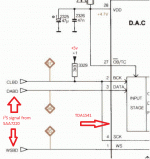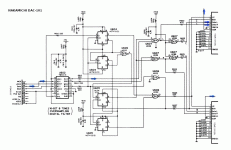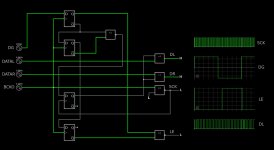Hello
The CD650 CD-player, who use a SAA7220 and a TDA1541, did use a 3k9 pull-up resistor BCK to +5V
Seem interesting, anybody try a pull-up resistor like this one ?
Thank
Bye
Gaetan
The CD650 CD-player, who use a SAA7220 and a TDA1541, did use a 3k9 pull-up resistor BCK to +5V
Seem interesting, anybody try a pull-up resistor like this one ?
Thank
Bye
Gaetan
Attachments
Last edited:
Hope you get an answer, looking for the right way to feed from a flipflop w or w/o the R in the line, so a can it be fed by a 5V clock directly or may I keep the RC wich is between the SAA7220 fed...
I still have that in mind:
I still have that in mind:
... the 7220 swings 5v pk-pk on its outputs, and the 1541 only needs a tiny current centred c1.4v to switch - it's a current-routing logic; the excess voltage swing just pushes HF currents into the dac.
Is anyone able to post or send me Guidos PMD100 TDA1541A schematic, the link in this thread no longer works.Hope you get an answer, looking for the right way to feed from a flipflop w or w/o the R in the line, so a can it be fed by a 5V clock directly or may I keep the RC wich is between the SAA7220 fed...
I still have that in mind:
Try again,
Is anyone able to post or send me Guidos PMD100 TDA1541A schematic, the link in this thread no longer works.
Is anyone able to post or send me Guidos PMD100 TDA1541A schematic, the link in this thread no longer works.
Pretty sure that schematic included a GAL. You would also need the code for the GAL if that was indeed the case.
Member
Joined 2018
f my memory serves me correctly, SAA7220 has 300H of DC offsets in its output data.
I would like to know is correct or not (Not sure, because it's three decades ago)
I would like to know is correct or not (Not sure, because it's three decades ago)
From memory its not that high, I seem to recall from my study 0x20. But it depends on the suffix letter of the SAA7220, I think I tested the B suffix.
Member
Joined 2018
Oh, That's awesome. Thanks for your memory.From memory its not that high, I seem to recall from my study 0x20. But it depends on the suffix letter of the SAA7220, I think I tested the B suffix.
I thought it must be one of the unknown reasons for its sound characteristics. Because It decreases the chance of Zero-Cross distortion.

Found some diagrams on the Chinese forum:

SAA7372 at 16.9MHz: but I thought, pin25 WCKO of PMD100 can be connected directly to LE of the TDA1541A...?

This is for the I2S output of the SAA7310: but shouldn't pin14 be tied HIGH...?

Glue logic for SM5813: again WCKO could directly be connected to LE, but the forum member wanted to match the timing requirements of the TDA...
Links to original forum posts: here and here and here.
SAA7372 at 16.9MHz: but I thought, pin25 WCKO of PMD100 can be connected directly to LE of the TDA1541A...?
This is for the I2S output of the SAA7310: but shouldn't pin14 be tied HIGH...?
Glue logic for SM5813: again WCKO could directly be connected to LE, but the forum member wanted to match the timing requirements of the TDA...
Links to original forum posts: here and here and here.
Last edited:
The 74HC74 serves here as reclocking of the LE signal in simultaneous mode.SAA7372 at 16.9MHz: but I thought, pin25 WCKO of PMD100 can be connected directly to LE of the TDA1541A...?
View attachment 1021070
So can a PMD100 be directly substituted for an SAA7200P/B without any other circuit mods?PMD-100: recommended!
Possible; yes.
Gluelogic: quite a bit
No. The SAA7220 is I2S in and I2S out i.e. serial L/R data in and serial L/R data out. The PMD100 is also serial data in but not I2S and parallel left and right data out.
Thank you.No. The SAA7220 is I2S in and I2S out i.e. serial L/R data in and serial L/R data out. The PMD100 is also serial data in but not I2S and parallel left and right data out.
- Home
- Source & Line
- Digital Line Level
- Is the SAA7220P/B really that bad ?




